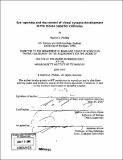Eye-opening and control of visual synapse development in the mouse superior colliculus
Author(s)
Phillips, Marnie A. (Marnie Ann)
DownloadFull printable version (18.02Mb)
Other Contributors
Massachusetts Institute of Technology. Dept. of Brain and Cognitive Sciences.
Advisor
Martha Constantine-Paton.
Terms of use
Metadata
Show full item recordAbstract
The mammalian superior colliculus (SC) coordinates visual, somatosensory, and auditory stimuli to guide animal behavior. The superficial layers (sSC) receive visual information via two major afferent projections: 1) A direct retinal projection and 2) an indirect projection from Layer V visual cortex. The retinal projection reaches the rat sSC by embryonic day 16, is topographic, and refines to form a high resolution map of visual space early in development, before eye-opening in rodents (-P12-P14). The cortical projection is delayed by about eight days, just reaching the sSC around P4, and does not complete its topographic refinement until around the time of eye-opening. These afferents compete for synaptic space during a time when patterns of spontaneous and evoked activity are rapidly changing. I have used the mouse sSC as a model system to test the role of new activity patterns due to the initial onset of visual experience after eye-opening in visual synaptic development. I have described the organization of retinal and cortical afferents and the laminar organization of the mouse sSC in Chapter 3. Previous work demonstrated eye-opening (EO) induces the appearance of dendritic PSD-95 and LTP in the sSC within 2-4 hours. (cont.) I provide evidence that EO-induced PSD-95 trafficking is required for the stabilization of new synapses in vivo as a result of patterned visual experience after eye-opening. mEPSC frequency recorded in a vertical neuronal subtype of the mid-SGS increases at least three-fold after eye-opening, indicating a rapid synaptogenesis that does not occur in PSD95KO mice, or in age-matched littermates deprived of initial visual experience. A structural analysis of these neurons revealed caliber-specific patterns of spine and filopodia development that depend on EO and the projection from visual cortex. Between P11 and P13, dendrites post-synaptic to cortical axons undergo an EO-independent tripling of filopodial density and an EO-dependent maintenance of dendritic spine density. These data suggest that rapid vision-induced trafficking of PSD-95 enables long-term potentiation and stabilization of newly formed cortico-collicular synapses in response to patterned visual stimuli. Furthermore, these data suggest that cortical inputs are sensitive to pattern vision deprivation between P12 and P13, but retinal inputs are not.
Description
Thesis (Ph. D.)--Massachusetts Institute of Technology, Dept. of Brain and Cognitive Sciences, 2007. "June 2007." Includes bibliographical references.
Date issued
2007Department
Massachusetts Institute of Technology. Department of Brain and Cognitive SciencesPublisher
Massachusetts Institute of Technology
Keywords
Brain and Cognitive Sciences.